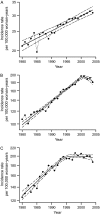Recent changes in breast cancer incidence in Spain, 1980-2004
- PMID: 19861303
- PMCID: PMC2778670
- DOI: 10.1093/jnci/djp358
Recent changes in breast cancer incidence in Spain, 1980-2004
Abstract
Background: Since the 1980s, Spain experienced two decades of sharply increasing breast cancer incidence. Declines in breast cancer incidence have recently been reported in many developed countries. We examined whether a similar downturn might have taken place in Spain in recent years.
Methods: Cases of invasive female breast cancer were drawn from all population-based Spanish cancer registries that had at least 10 years of uninterrupted registration over the period 1980-2004. Overall and age-specific changes in incidence rates were evaluated using change-point Poisson models, which allow for accurate detection and estimation of trend changes. All statistical tests were two-sided.
Results: A total of 80,453 incident cases of invasive breast cancer were identified. Overall age- and registry-adjusted incidence rates rose by 2.9% (95% confidence interval [CI] = 2.7% to 3.1%) annually during the 1980s and 1990s; there was a statistically significant change in this trend in 2001 (95% CI = 1998 to 2004; P value for the existence of a change point <.001), after which incidence declined annually by 3.0% (95% CI = 1.8% to 4.1%). This trend differed by age group: There was a steady increase in incidence for women younger than 45 years, an abrupt downturn in 2001 for women aged 45-64 years, and a gradual leveling off in 1995 for women aged 65 years or older. Separate analyses for registries that had at least 15 years of uninterrupted registration detected a statistically significant interruption of the previous upward trend in breast cancer incidence in provinces that had aggressive breast cancer screening programs and high screening participation rates, including Navarra (change point = 1991, P < .001), Granada (change point = 2002, P = .003), Bizkaia (change point = 1998, P < .001), Gipuzkoa (change point = 1998, P = .001), and Araba (change point = 1997, P = .002).
Conclusions: The recent downturn in breast cancer incidence among Spanish women older than 45 years is best explained by a period effect linked to screening saturation.
Figures


References
-
- Parkin DM, Whelan SL, Ferlay J, Storm H. Cancer Incidence in Five Continents. Vol 1–8. Lyon, France: IARC; 2005.
-
- Parkin DM, Fernandez LM. Use of statistics to assess the global burden of breast cancer. Breast J. 2006;12(suppl 1:):S70–S80. - PubMed
-
- Botha JL, Bray F, Sankila R, Parkin DM. Breast cancer incidence and mortality trends in 16 European countries. Eur J Cancer. 2003;39(12):1718–1729. - PubMed
-
- Bosch X. Investigating the reasons for Spain's falling birth rate. Lancet. 1998;352(9131):887. - PubMed
-
- Aranceta-Bartrina J, Serra-Majem L, Foz-Sala M, Moreno-Esteban B. Prevalence of obesity in Spain. Med Clin (Barc) 2005;125(12):460–466. - PubMed
Publication types
MeSH terms
LinkOut - more resources
Full Text Sources
Medical

